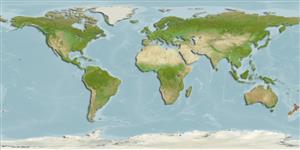>
Blenniiformes (Blennies) >
Tripterygiidae (Triplefin blennies) > Tripterygiinae
Etymology: Cryptichthys: Greek, kryptos = hidden + Greek, ichthys = fish (Ref. 45335); jojettae: Named after Jojette Drost, former staff member of the National Museum (New Zealand), collector of the paratypes of this species..
Environment: milieu / climate zone / depth range / distribution range
पारिस्थितिकी
समुद्री ड़िमरसल; गहराई सीमा 0 - 12 m (Ref. 13227). Temperate
Southwest Pacific: endemic to New Zealand.
आकार / वज़न / Age
Maturity: Lm ? range ? - ? cm
Max length : 6.0 cm TL पुल्लिंग / अलिंग; (Ref. 9003)
Short description
पहचान कुंजी | आकृति विज्ञान | मौरफोमैटरिक्स
पृष्ठीय रीढ़ (सम्पूर्ण) : 18 - 21; पृष्ठीय सौफट रेज़ (सम्पूर्ण) : 9 - 11; गुदा कांटा: 0; ऐनल सौफट रेज़: 20 - 22. Head and body red to reddish brown with pinkish blotches and prominent dark columns and arches running onto belly. Fins of various hues of pink and red. Distinguished from other triplefins by the distinctive color pattern and the continuous lateral line extending to the caudal peduncle.
Adults inhabit rock pools and in surge zones, especially in exposed areas. Usually on steep slopes or sides of boulders encrusted with invertebrates and algae (Ref. 13227). Eggs are hemispherical and covered with numerous sticky threads that anchor them in the algae on the nesting sites (Ref. 240). Larvae are planktonic which occur primarily in shallow, nearshore waters (Ref. 94114).
Life cycle and mating behavior
Maturities | पुनरुत्पत्ति | Spawnings | Egg(s) | Fecundities | लार्वा
Fricke, R., 1994. Tripterygiid fishes of Australia, New Zealand and the southwest Pacific Ocean (Teleostei). Theses Zool. 24:1-585. (Ref. 13227)
IUCN Red List Status (Ref. 130435)
Threat to humans
Harmless
Human uses
मात्स्यिकी: कोई रुचि बग़ैर
साधन
Special reports
Download XML
इंटरनेट स्रोत
Estimates based on models
Preferred temperature (Ref.
123201): 11.9 - 18.5, mean 15.9 °C (based on 131 cells).
Phylogenetic diversity index (Ref.
82804): PD
50 = 1.0000 [Uniqueness, from 0.5 = low to 2.0 = high].
Bayesian length-weight: a=0.00676 (0.00364 - 0.01255), b=3.09 (2.92 - 3.26), in cm total length, based on LWR estimates for this species & (Sub)family-body (Ref.
93245).
Trophic level (Ref.
69278): 3.2 ±0.4 se; based on size and trophs of closest relatives
लौटाव (Ref.
120179): ऊंचा, न्यूनतम जनसंख्या दुगनी समय अवलागत 15 महीने। (Preliminary K or Fecundity.).
Fishing Vulnerability (Ref.
59153): Low vulnerability (10 of 100).
Nutrients (Ref.
124155): Calcium = 283 [143, 976] mg/100g; Iron = 1.08 [0.47, 2.38] mg/100g; Protein = 17.9 [16.4, 19.4] %; Omega3 = 0.409 [0.136, 1.260] g/100g; Selenium = 14 [4, 46] μg/100g; VitaminA = 9.64 [1.63, 56.15] μg/100g; Zinc = 1.7 [0.9, 3.0] mg/100g (wet weight);
